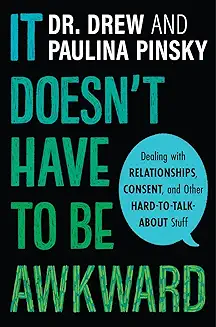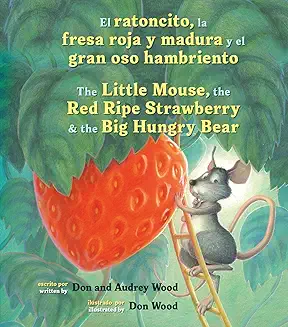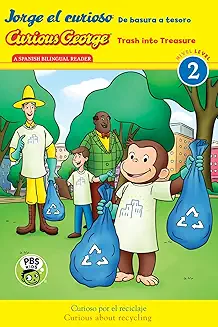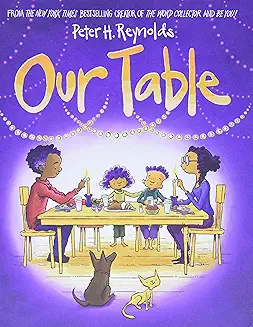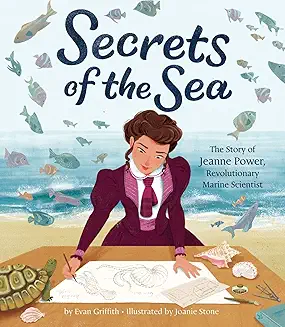Straight Talk for Librarians: This book is an important addition to the ever-challenging human growth and development section of the library. The majority of the text is focused on taking care of oneself, communicating clearly and effectively, and making informed and important decisions within relationships. Though the text does address potentially controversial topics like sex and masturbation, these are discussed without specifics of the acts themselves, and always tied to important emotional factors, like consent, self-awareness and understanding, and breaking through common misconceptions and stereotypes. That being said, the authors (without details) encourage masturbation as a self-understanding exercise, and suggest that sex does not only have to happen in committed relationships as long as TCB is in operation, so more conservative parents or communities may struggle with such concepts. Many parents would hand this title to middle school students, but it is probably better housed in a high school collection for general use. Overwhelmingly, though the topics of this book could indeed feel awkward, the focus is on healthy relationships and interactions with a focus on understanding and communicating emotions, which would make it a useful text related to human health or biology curriculum, and a valuable addition to a collection for teens who are experiencing or surrounded by these concepts for the first time.
Monday, April 8, 2024
It Doesn't Have to Be Awkward: Dealing with Relationships, Consent, and Other Hard-to-Talk-About Stuff, written by Drew Pinsky and Paulina Pinsky, reviewed by Bethany Bratney
Stolen Justice: The Struggle for African American Voting Rights, written by Lawrence Goldstone, reviewed by Bethany Bratney
Straight Talk for Librarians:
Friday, April 5, 2024
Bisa's Carnaval, written by Joana Pastro and Carolina Coroa, reviewed by Klaudia Janek
Straight Talk for Librarians: This book is just as colorful as the title suggests. You can feel the Carnaval atmosphere with the setting and the colors the illustrator chose. You see a small seaside village where Clara and her Bisa live. You can tell they are somewhat poor, but still make the best of their situation by making a costume. There are Portuguese words sprinkled throughout the text and in the illustrations. Both the author and the illustrator originate from Brazil and can showcase with some authenticity the Carnaval of Olinda, a city in the northeast of Brazil. There is a glossary at the end. A great book to add to any elementary school library collection to celebrate diverse holidays and celebrations of the world. A highly recommended purchase for any IB school library collection because of the global community emphasis. All readers will appreciate the multi-generational relationship between Clara and her Bisa. A sweet, fun read.
Thursday, April 4, 2024
The Little Mouse, the Red Ripe Strawberry & the Big Hungry Bear El ratoncito, la fresa roja y madura y el gran oso hambriento, written by by Audrey Wood and Don Wood, reviewed by Klaudia Janek
Straight Talk for Librarians: The language development with a familiar story will be beneficial for students learning either Spanish or English. Perfect for any bilingual elementary library or classroom. Schools with mostly English speakers will benefit from this book if they offer Spanish classes. I am putting this book in my high school library because we have a lot of new Spanish language learners. This is perfect for first-year students learning Spanish. They might already be familiar with these characters and will appreciate both languages on the page. Students will learn new vocabulary and practice their reading comprehension.
Curious George: Trash into Treasure | Jorge el curioso: De basura a tesoro, written by H. A. Rey, reviewed by Klaudia Janek
Straight Talk for Librarians: Everyone loves Curious George! This book is adapted from a TV show. The language development with a familiar story will be beneficial for students learning either Spanish or English. Perfect for any bilingual elementary library or classroom. Schools with mostly English speakers will benefit from this book if they offer Spanish classes. I am putting this book in my high school library because we have a lot of new Spanish language learners. This is perfect for first year students learning Spanish. They will be familiar with the characters and will appreciate both languages on the page. Students will learn new vocabulary and practice their reading comprehension.
Wednesday, April 3, 2024
Clarinet & Trumpet, written by Melanie Ellsworth, illustrated by John Herzog , reviewed by Klaudia Janek
Straight Talk for Librarians: This book is a perfect introduction to some music vocabulary and band instruments. The book can shake and rattle like a maraca, which young readers will LOVE! It’s a great lesson on how the instruments are grouped together in a band or orchestra, specifically brass and woodwinds. It has vocabulary like crescendo and flat, which any music teacher will appreciate. It makes for a great read-aloud and could be done with different voices. This would make for a great school librarian and band teacher collaboration. The band teacher could display all the instruments presented in the book. I do think some of the vocabulary needs to be defined. A music teacher could demonstrate the difference between a flat and a sharp note. Some settings in the illustrations include a stage and a practice room. The emotions conveyed by the instruments are cute and funny. The illustrator did a great job with that. A perfect choice for any elementary school library and music classroom. It might not be the best choice for any sort of sustained silent reading because the book is loud :) But that is what makes it even more fun. My 9-year-old reader summarized the story as “they hated each other and then they liked each other.”
The Goody, written by Lauren Child , reviewed by Klaudia Janek
Straight Talk for Librarians: Lauren Child is the author and mixed media illustrator of this book. It thought the illustrations looked familiar and it turns out she is also the creator of Charlie and Lola. This is a beautiful book with fun font. It’s a good lesson for young children and parents alike. It makes for a good read aloud. This would be a good fit for any elementary school library. Humor is woven throughout the text and the illustrations. I’m not sure if “goody” is more British slang? However, it can certainly be explained with our US “goody-goody two shoes” phrase. I would say the main takeaway is to not label children. It would be a great purchase for any elementary school library. It makes for a good read-aloud and for silent reading. I think there could be a lot of creative crafts that can go along with this story.
Tuesday, April 2, 2024
Hip, Hip...Beret! written by Melanie Ellsworth and Morena Forza, reviewed by Klaudia Janek
Straight Talk for Librarians: This is a sweet story full of rhymes and examples of words we use in the English language that are from the French language. The story is cleverly set in France. The seasons go from summer, to fall, to winter and finally to spring. The colors in the illustrations match the seasons and the scenes that depict Paris employ a very French color palette. There is lots to look at and young readers will love feeling the fabric of the beret. This book would be perfect in a French bilingual school. It would also be perfect for any IB school. The IB learner profile attribute that stood out to me is “balanced”. Belle had very balanced emotions when her brand-new hat flew away. A great addition to any elementary school library.
Our Table, written by Peter H. Reynolds, reviewed by Klaudia Janek
Straight Talk for Librarians: A cautionary tale for all families today who don’t always take the time to have a meal together. An all too true telling of how we are all attached to technology more than the people who surround us. It will make readers of all ages consider how much time they spend connected to technology instead of their friends and family. It makes for a good read-aloud. It would be a popular choice for any elementary school library. For any PYP IB programs, there is a focus on being a Communicator in the Learner Profile. There could be lots of library activities to complement this book. My 9-year-old reader stated, “It was really short but still super good!” Highly recommended.
Monday, April 1, 2024
Secrets of the Sea: The Story of Jeanne Power, Revolutionary Marine Scientist, written by Evan Griffith and Joanie Stone, reviewed by Klaudia Janek
By the Book: A Novel of Prose and Cons, written by Amanda Sellet, reviewed by Klaudia Janek
Straight Talk for Librarians: I LOVED this book! I like the classic literary quotes sprinkled throughout the book. I like the focus on family and friendships. I like that Mary didn’t try to hide that she and her family were super smart. The developing romance between Mary and Alex was funny, witty, and swoon-worthy. The cast of characters draws the reader into the fun drama of this book. There are lots of emotions in this wide circle, but the story flows and draws the reader in. There are a lot of laugh-out-loud moments and an HEA that the author did a nice job of tying all the pieces together. It would be easy to imagine being in the quirky town and settling into the local cozy bookshop called Toil & Trouble. This book is a 2020 release and didn’t seem to get the attention that it deserves. The cover art is very bookish in muted colors. Overall, it’s a smart, funny, and literary contemporary YA romance. I highly recommend this book for any high school library.
Friday, March 29, 2024
Gloom Town, written by Ronald L. Smith, reviewed by Klaudia Janek
Straight Talk for Librarians: Having read and enjoyed some of Ronald L Smith’s previous books, you can tell this is his setting and style of storytelling. Diving into the book, it seems like it will be realistic fiction. The story IS set in what seems like a fictional English seaside town. But right away you get the feeling something is wrong and that evil might be lurking beneath the surface - then the story has elements of magical realism. There is a little bit of dabbling with the occult in this story. I’m not sure that the creature is connected to a mythological creature or if it is made up by the author. Either way, it is a bit scary (in a fun way). I enjoyed the friendship between Rory and Izzy. The mystery part of the story began to be solved when Rory started telling adults about his problems and allowing his friends to help him. The cover art on this book is gorgeous and speaks to the diverse characters without trying too hard. The author always includes diversity in his books in a natural way. Lots of bad creatures die, which resolves the storyline. The author throws in some twists and turns at the end, which makes the end even better and pulls together some treads from the beginning. This is a great pick for a middle school library. I’d recommend it to students looking for stories about witches, mages, scary creatures, mystery, high paced adventure and a fun cast of characters.
Far from Fair, written by Elana K. Arnold, reviewed by Klaudia Janek
Straight Talk for Librarians: I thought the cover of this book was beautiful and really went with the camper life theme. I think most readers would sympathize with Odette. She is having a lot of hardships in life and a lot of changes are coming too quick. This story explored friendships, family dynamics and grief. This book is targeted to ages 9-13 (grades 3-7) and I certainly believe that grief has a place in fiction and it needs to be explored. However, I think the author went too far with diving into Oregon’s Death with Dignity law and sort of compared euthanasia to putting down a pet. It got even more political when Odette’s brother had an exotic animal as a pet (ferret) which is illegal in California, but legal in Oregon. It’s these political state laws, which are complex, that really hinted at ideologies that might not yet be appropriate for the age group targeted. Depending on religious leanings, parents might be completely opposed to the POV presented in this book. I think the intended age group is too young for the level of detail of grandma taking the drug cocktail to die. There is also the possibility that younger readers are not well-schooled in individual state rights and might not fully understand what is going on between California and Oregon. Only one of the professional reviews mentions this and others are ambiguous about the details.




